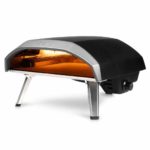What Is a Pizza Stone Made Of? (Quick Facts)
It can be pretty frustrating to make pizza at home because it just doesn’t come out the same way as the ones from the restaurant.
You followed all the instructions, you’ve been incredibly patient with the hours it took for the dough to rise, and you got the freshest, most authentic (and pricey) ingredients in the market to top it all off. But you just can’t get that slightly charred, crispy bottom and chewiness. Worse, the crust is slightly moist from the sauce and the toppings tend to get overcooked.
What happened?!!
Brick Oven = Pizza Stone
High-quality pizzas are cooked inside a fiery hot brick oven. You’ll actually see the difference between gourmet pies baked in a traditional wood-fired forno and the ones that come from fast-food chains’ conventional ovens.
But it’s utterly impractical to demolish your whole kitchen just to have new masonry installed. And this is the reason for the resurgence of the baking or pizza stone.
A Brief History of the Pizza Stone
Yes, it is ‘resurgence’ instead of invention, because this tool has actually been around for a millennium.
Bread baking in ancient Egypt has been well-documented, with clay moulds and similar artefacts discovered in pyramids. Identical implements were also found in Greece and Rome, where the earliest civilisations began. Back then, they would simply place their prepared dough on these pans and cook it over embers. When masonry ovens were developed, this method pretty much went obsolete.
The modern pizza stone was re-introduced in the 2000s mainly because cooks realized that cooking over this surface is so much better than on the metal plates of high-tech ovens.
How Does the Pizza Stone Work?

Now that we’re done with history, let’s tackle the science behind this simple tool.
Pizza stones, from the term itself, are made from stones, either mined from the earth and cut to size or formed into shape from a mixture of soil and clay. What makes these effective is their ability to pull heat in and conduct it fast. It also retains the high temperature longer.
Dough, sauces, and meat toppings are inherently moist, as they contain a certain amount of liquid. When these touch the incredibly hot stone, the moisture is wicked away, cooking food evenly from top to bottom in just a few minutes.
Types to Choose From
There are different variants of baking stones available in the market today. Knowing each and understanding how they work can help you decide what suits your needs most.
- Clay or Ceramic
Made from natural materials (a mixture of soil and clay), these are typically regarded as safe and effective. The problem is that they can break when subjected to sudden temperature fluctuations. To avoid this, it must be carefully warmed first and then left inside the oven as the temperature goes down.
- Cordierite
Used for making industrial kilns, this is considered the best material for our featured kitchen tool. It can withstand high temperatures without cracking, is amazingly porous and conductive, and is resistant to wear and tear. Many have also lauded its lightweight feature, making it perfect for home use.
- Cast Iron
Well-loved for their versatility, cast iron pans and sheets may also be used as pizza stones because they can absorb and retain heat pretty well. However, you will need to preheat this a bit longer than the ceramic and cordierite variant.
- Steel
Metal is a good enough heat conductor so it will cook your dishes through. However, it won’t give you those brown spots at the bottom of the crust seen in authentic Neapolitan recipes. Very recently, a special baking steel was introduced in the market which supposedly works the same way as clay and ceramics. But since this is a pretty new product, it will cost you a bit more.
Care Tips You Should Know
One of the biggest complaints people have about pizza stones is that they crack on their own. That’s very possible when you have no idea how to use or take care of it. So here are some great tips:
- Preheating is a must!
The oven and the stone should heat up at the same time. In addition, you need to cool the stone down together with the oven. Sudden temperature change is the main reason for cracking. Placing a really cool stone inside a hot environment is a sure way to ruin this tool.
Once it has cooled completely down, use a firm brush or scraper to remove any melted and dried particles and then rinse with water. Try not to use detergent on it because it could seep in and cause the stone to taste like soap.
Ceramic, cordierite, and cast iron are supposed to be non-stick if they are properly seasoned. Simply wipe the whole surface with neutral vegetable oil and heat it up in the oven for an hour.
Is This an Essential Kitchen Tool?
Some swear that the pizza stone can be quite versatile in the kitchen. But many disagree with that because this tool really does one thing: increase the temperature of the surface for baking bread (pizza included). However, if you’re the type who loves baking, here are some reasons why it’s a must-have:
- Cooks food evenly
Because of its ability to absorb, conduct, and retain heat, you’re assured that the pizza dough and toppings are cooked at the same time. While turning it ever so often can help, you could just leave it there for just four minutes or until the cheese is bubbling. Take the pizza out and you’ve got yourself a meal!
- Crispy crust, chewy insides
You’ll get that result because of the stone’s porous surface. As explained above, it wicks any moisture away, leaving the bottom of the dough completely dry.
- Retains heat well
If you’re cooking several batches of pizza, you don’t have to worry about additional pre-heating in between pies. Just stick one right after another! You can feed a large party in under an hour because the pizza cooks fast!
If you are a huge pizza fan and go through several pies a week, this is a relatively affordable investment compared to getting a full kitchen renovation. At about $30, you can own a pretty high-quality piece already. And if you properly care for it, this can last for years!






